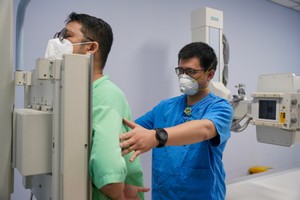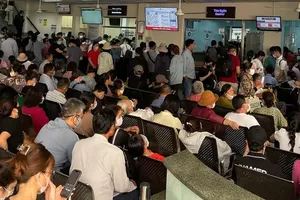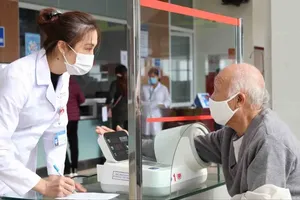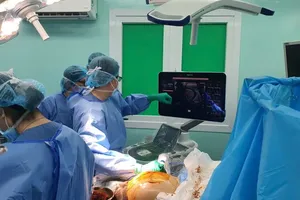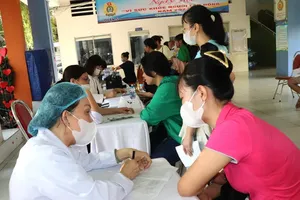
Always thinking of himself as perfectly healthy, 29-year-old Nguyen Hoang Tung from Binh Thanh Ward of HCMC was, understandably, stunned when doctors diagnosed him with an acute myocardial infarction. He needed an emergency coronary stent procedure just to save his life.
Tung recounted that while at work recently, he felt a tightness in his chest and slight shortness of breath but chalked it up to stress. It wasn’t until the chest pain became excruciating and he felt utterly exhausted that his colleagues rushed him to HCMC University Medical Center. Doctors there quickly determined a branch of his coronary artery was blocked; had he arrived just a little later, he might not have survived.
In another case, 23-year-old P.N.L. from Vinh Long Province was hospitalized with severe chest pain and extreme shortness of breath. She was diagnosed with severe mitral valve regurgitation, complicated by vegetation on the valve. Ms. L. was immediately taken into endoscopic heart surgery to replace the valve and remove the dangerous growth.
According to Assoc Prof Nguyen Hoang Dinh, PhD MD, Vice Director of HCMC University Medical Center, the hospital now receives dozens of cases of young people with acute cardiovascular disease every month, many of whom are just in their 20s or 30s.
Cardiovascular disease, he explains, is a “silent killer” precisely because it’s so dangerous and strikes so unexpectedly. It stems from a variety of causes and manifests in different pathologies, such as hypertension, heart valve stenosis or regurgitation, myocardial ischemia, arrhythmia, and hypertrophic cardiomyopathy. If not treated, or not treated thoroughly, it will progress severely, with the most dangerous outcomes being sudden death or irreversible heart failure.
Tam Duc Heart Hospital, Cho Ray Hospital, People’s Hospital 115, and Gia Dinh People’s Hospital are all reportedly observing the same “rejuvenation” trend in cardiovascular patients. When these young patients are admitted, they almost always share a common profile: high work pressure, a sedentary lifestyle, irregular eating habits, and, for some, accompanying obesity, smoking, or frequent alcohol consumption.
According to Level-II Specialist Le Trung Nhan, Head of the Examination Department at Cho Ray Hospital, an unhealthy lifestyle is the “biggest culprit” driving this trend. Beyond that, many young people are simply complacent, skipping regular health check-ups, which leads to their diseases being detected far too late.
“Cardiovascular disease doesn’t have an age boundary,” he stated. “Young people today are under immense pressure, enduring prolonged stress, staying up late, and eating without control. All of this contributes to a much higher risk of heart disease at a very early age. In addition, the rapidly increasing rates of obesity, hypertension, and dyslipidemia (blood fat disorders) in the 20-40 age group are themselves an alarming risk factor.”
Assoc Prof Nguyen Hoang Dinh, PhD MD, reports that cardiovascular disease in young people doesn’t just damage their health; it hammers labor productivity and creates a significant financial burden for both their families and society. “A single acute myocardial infarction case can cost hundreds of millions of Vietnamese dong (thousands of US dollars) for the intervention, treatment, and rehabilitation,” he explains. The real tragedy, he notes, is that “80 percent of events from this disease could be prevented” if the risk factors were just caught early.
To limit the possibility of contracting cardiovascular disease, young people must shift their mindset from treatment to prevention. This means arming themselves with knowledge, learning to identify early risk factors such as smoking, inactivity, an unhealthy diet, or chronic stress, and then proactively changing their lifestyle.
“Early prevention is the best way to protect your heart,” Assoc Prof Dinh emphasized. “At the same time, you have to listen to your body. Don’t ignore abnormal signs like palpitations, chest pain, fatigue, or shortness of breath. Anyone with known risk factors like obesity, high blood pressure, diabetes, or a family history of heart disease should be getting regular screenings to detect abnormalities early.”
According to World Health Organization (WHO) statistics, cardiovascular disease is the number one cause of death globally, claiming over 20.5 million lives annually. Here in Vietnam, that number reaches approximately 200,000 cases, accounting for 33 percent of all deaths. This places the nation among those with the fastest-rising rates of cardiovascular disease in the Asia-Pacific region. It’s estimated that 1 in every 4 adults has a cardiovascular condition, and the trend is overwhelmingly skewing younger.
Prof Dr Pham Manh Hung, President of the Vietnam Association of Interventional Cardiology, argues that reducing this burden requires an “integrated prevention strategy.” This includes public health education (like cutting salt, eliminating trans fats, and limiting ultra-processed foods), as well as promoting global policies to reduce risk factors.
He also called for applying advanced technology to analyze and calculate risks for high-risk groups and building a fair and sustainable healthcare system that prioritizes prevention, not just treatment when sick.
Faced with this reality, Deputy Minister of Health Tran Van Thuan stated that the Ministry of Health is building a “proactive, preventive health model” for cardiovascular disease. The strategy, he said, includes implementing a nationwide screening program integrated with electronic health records to create a data platform for lifelong health management.
Simultaneously, the ministry is working to standardize professional capacity at high-tech heart centers and enhance the diagnostic and emergency handling capabilities at the grassroots level, all to make the most of the “golden time” to save patients’ lives.

